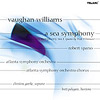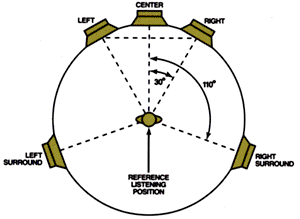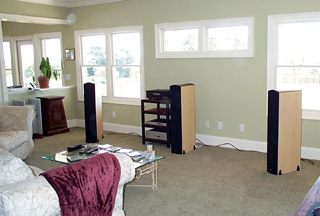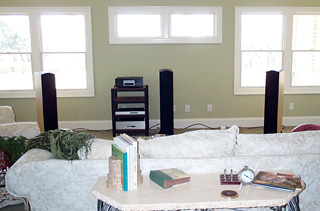![[SoundStage!]](../sslogo3.gif) Surrounded! Surrounded!Back Issue Article |
|||||
December 2003 Paradigm Reference Studio 100 v.3 Loudspeakers -- Times Five!
The ITU standard (International Telecommunications Union ITU-R BS.775-1) for multichannel music calls for identical speakers arranged in a specifically designed circular-shaped pattern (the mains are 30 degrees from the center-channel, while the surrounds are 110 degrees from the center speaker). This configuration was widely adopted by recording engineers as the gold standard for surround music and is, in fact, the system most used in the production of the new music you hear on multichannel SACDs and DVD-As. It stands to reason that to experience what the artist/engineer originally intended, an arrangement similar to that used in the mastering process should be duplicated in your home. System configuration Someone in his infinite wisdom once said that all speaker systems involve compromise. This is no more evident than when setting up a surround music system. The most obvious problem with most multichannel setups is that the center-channel speaker doesn’t sonically match the main left and right speakers. There’s the most obvious fact that most center-channels are configured with a horizontal array of drivers -- as opposed to the vertical array in a conventional speaker -- and are designed such that the speaker can be placed atop a monitor. The problem, without delving into technical issues such as driver dispersion and cabinet diffraction, is that the only speaker that will sound identical to another speaker is another identical speaker. That means the typical home-theater center-channel will always sound different than its left and right counterparts. Different, in this case, is a bad thing. A similar argument regarding the surround channels can be made, albeit one involving other technical aspects of speaker design. Many surround speakers are specified for wall mounting, for example, and this near-boundary placement naturally affects the sound. Second, many surrounds are designed to create a diffuse soundfield, which in the case of multichannel music is not ideal. A diffuse-sounding surround speaker usually has drivers configured such that they face away from the listener so that localized sound is avoided. The thought is that immersing one in sound is preferable in a theater setting with theater soundtracks. Sound effects in a movie do benefit, occasionally anyway, from this type of radiation pattern; good music reproduction, however, requires a setup that can accurately place instruments within a space. The goals for each system are diametrically opposed. Some technical compromises are acceptable in home theater, such as bass management and delay-time adjustment. For best performance with music, however, these processing arrangements should be avoided whenever possible; a reference-grade surround music system demands a better solution. The answer is to have five identical full-range speakers assembled in an ITU-standardized arrangement. You avoid the pitfalls encountered with standard home-theater processing and speaker arrangement, and that should translate to better sound. The approach I took with the system under evaluation was to arrange an ITU-standardized system using five Paradigm Reference Studio 100 v.3s. The results were stunningly good. The rest of the review system consisted of my Orpheus Laboratories Two multichannel preamp, Esoteric DV-50 universal A/V player, and Coda Technologies amplification. The speakers
The Studio 100 v.3 utilizes a 1" aluminum-dome tweeter and a 7" mica-polymer midrange. These two drivers, along with the three woofers mentioned above, are aligned in a tight vertical array on the narrow front baffle; the drive units are so close that their exterior housings actually touch. The cabinet is finished with several dissimilar materials that give the speaker a visually interesting profile. The top plate is rubberized and convex in shape, while the front baffle is a vinyl material scored to look like brushed aluminum. The sides and back are finished in a very-real-appearing vinyl laminate available in faux sycamore, cherry, rosenut, or black ash. Unlike most loudspeakers I’ve had the pleasure of hearing, the Paradigms are designed to work with their grilles left on. This is refreshing; most listeners fumble with the need for grilles for practical reasons and the very real performance degradation imparted by most fabric coverings. The back of the Studio 100 v.3 sports two sets of substantial biwirable gold-plated binding posts with a solid jumper for single wiring. Lastly, it’s worth noting that the Studio 100 v.3s are designed to work in an average Joe’s room. According to Paradigm this is accomplished through design parameters that include flat response across the midrange, wide and even horizontal and lateral dispersion, and low distortion. That sounds like a pretty good recipe for success, and they are design principles Paradigm incorporates into all of their loudspeakers. Paradigm is also mighty proud of their 33,000-cubic-foot anechoic chamber, where these design principles are verified through extensive measurement. Performance The Paradigm Reference Studio 100 v.3 strikes me as the perfect speaker for plowing into high-resolution multichannel music. Its clarity, dynamic range, extended frequency response, and pinpoint imaging, are traits that ideally compliment SACD and DVD-Audio. And when you consider that you can buy five of these for $5500 USD ($2200/pair), the deal is even sweeter. I’d guess that most loudspeakers that compete with the Studio 100 v.3 are in $5500-per-pair range. In this case, for that kind of scratch, you get the whole multichannel shooting match.
But how does excellent times five sound? Is there a better disc to audition a multichannel music system than Pink Floyd’s The Dark Side of the Moon SACD [Capitol CDP 7243 5 82136 2 1]? The entire five-speaker array is exercised hard as the surrounds are very active, literally engaging the listener with the mad sounds of Floyd. The overall nature of the sound is pristinely clear, with snappy dynamics and quick transients. With the Paradigms surrounding me I was mesmerized by "Time" and "Money." The room was pierced with energy and feeling. I heard no discontinuity from the center-channel to mains to surrounds and back again. The ideal sound for a system of this sort is seamlessly coherent, and that’s just what I heard listening to this SACD over the Paradigms. With music like DSOM presented with truly exceptional clarity, a lesser speaker system might soften the detail or conversely overemphasize certain frequencies. The Paradigms pulled off a virtual hat trick by not falling prey to either commonly heard mistake. They dazzled me with their ability to stay balanced, play loud, and play clear -- and when that sound is coming from all five positions around the room, the effect is amplified. Talk about intense. Clarity is, in fact, a defining term with this system. Whether it be vocals, drums, guitars, or anything in between, it all comes through unscathed by the speakers. And with DSOM in particular, you need this clarity in all five positions around you. Most multichannel-music discs that I enjoy listening to are subtler in their use of the rear channels. But reproducing ambience in a way that immerses you in the experience instead of distracting by calling attention to the speakers’ locations requires stealthy sonic performance and a careful setup. Direct radiators such as the Studio 100 v.3 have the ability to image precisely, but with ambient information you need a non-localizable sound. Contrary to popular opinion, this disappearing act can be attained with a speaker like the Studio 100 v.3 if the surrounds are balanced perfectly in level and placed equidistant to the listening position as the mains. If they’re too close to the listener or too high in level in relation to the front three loudspeakers, all bets are off. Perhaps that’s why multichannel music can be such a balancing act -- the setup and product selection involved are both key. I’ve stated before that setting delay times can’t help a speaker’s drivers integrate more smoothly, and channel balancing can’t ameliorate frequency-response anomalies, and we all know that less processing is better than more. So it stands to reason, and is borne out in practice, that letting five excellent-sounding full-range speakers in a good room just do their thing makes magic. Over and over, magic is what I heard with the five Studio 100 v.3s. Listen to Vaughn Williams’ A Sea Symphony (Robert Spano, conductor; Atlanta Symphony Orchestra and Chorus [Telarc SACD 60588]) at realistic volume levels. This critically acclaimed release garnered a lot of well-deserved attention from the press, and one listen demonstrates why. The sound is pristinely recorded with specific but critical use of the surrounds. With the lights off you completely lose the walls of your room -- talk about atmosphere! You hear the sound of the orchestra and the chorus, but you also hear the space around you -- and that space is what helps create the illusion of live music. To produce the scale required for this work, though, you need speakers that can produce massive sound, and the Paradigms deliver. Sinatra at the Sands on DVD-Audio [Reprise R9 73777] contains some of the best multichannel music in the catalog today. The live ambience and the instantly recognizable vocal signature of Old Blue Eyes combine for a real make-it-or-break-it speaker test. It was quite clear listening to this disc that the Studio 100 v.3’s vocal reproduction is as Paradigm states: clear and smooth, but also full and weighty. The front stage, anchored by the solid vocals, was coherent and seamless when Count Basie and Orchestra were especially active. And the image height was placed so accurately that I felt as if I were in the audience looking up slightly at the performers. I’ve had other excellent performers through the "Surrounded" system as of late. Last month Soliloquy paid a visit: I assembled a $5297 system comprising four 5.3 floorstanders and a C-3 center-channel (not including the $1699 S-10c subwoofer). I found the overall sound to be smooth, with silky highs and extended bass response. Although not the last word in detail, the laid-back sound was easy to relax into. The Paradigm Reference setup was a study in contrasts. The top end of the sound spectrum was quite a bit more detailed, which served Sinatra at the Sands by illuminating ambient information with more realism; you’ll more clearly hear the crowd, for example. As well, the Paradigms, no doubt owing to their more generous driver complement, play louder and with more dynamic authority. A Sea Symphony demands realistic scale, for example, this achieved in no small part through prodigious volume level. I need a system that is dynamically capable of overkill, and the Paradigms can play very loud when need be. Having a matched center-channel also made the front stage as seamless as I could want. Three Studio 100 v.3s created quite a panoramic view in front of me when the music called for it, as with Sinatra at the Sands. I have confidence that the Soliloquy system could accomplish the same with a third 5.3 up front, but as it stands the C-3 couldn’t quite pull it off; there’s simply a performance gap between the C-3 and 5.3 that involves slightly different tonality and dynamic presentation. This is no admonishment towards Soliloquy, but against setting up anything but a system with a matched center-channel. Bass response was sufficiently deep with both systems, but the Paradigms did possess more headroom down low, which led to an effortless quality in the bass that the Soliloquy speakers couldn’t quite duplicate. The bottom line For those music lovers who want to enjoy all that the high-resolution SACD and DVD-A formats have to offer, a matched multichannel system featuring full-range loudspeakers is ideal. Maybe my head is in the clouds, but I think $5500 for a full five-channel Paradigm Reference system filled with cutting-edge drivers, highly engineered cabinets and crossovers, and the ability to sound extended, focused, dynamic, and clear as a bell, is a steal. In fact, I feel so strongly that this speaker system is the real-world reference, it will remain a permanent part of the "Surrounded" reference system. ...Jeff Fritz
|
|||||
|
|||||
![[SoundStage!]](../sslogo3.gif) All Contents All ContentsCopyright © 2003 SoundStage! All Rights Reserved |
 I’d prefer if you
considered my reporting of this month’s Multichannel Pick of the Month as fashionably
late, as opposed to yesterday’s news. Because if you’re just now getting around
to building your multichannel music collection, then this SACD should be at the top your
must-buy list. And I suspect it will still be on the top of that list years from now. This
is a classic by any measure and will stand the test of time.
I’d prefer if you
considered my reporting of this month’s Multichannel Pick of the Month as fashionably
late, as opposed to yesterday’s news. Because if you’re just now getting around
to building your multichannel music collection, then this SACD should be at the top your
must-buy list. And I suspect it will still be on the top of that list years from now. This
is a classic by any measure and will stand the test of time. The Studio 100
v.3 is a large three-way floorstanding speaker measuring 44.5"H x 8.25"W x
17"D and weighing a healthy 81 pounds each. With a rated frequency response extending
down to 28Hz (-3dB in a "typical room") it covers all but the most subterranean
bass. With three 7" mineral-filled polypropylene woofers providing the oomph
there’s plenty of dynamic capability when the music calls for it -- and many
high-resolution sources do call for it. What this means in real terms is that you
don’t need to augment the five primary channels with a subwoofer -- the sub is only
called upon for the dedicated LFE channel, and then only when one is present on the
soundtrack. Remember that if a speaker is not designed for an 80Hz crossover such as that
employed in a typical home-theater receiver, the result when implementing such a filter on
a speaker is variable at best. Ask most speaker designers how their stereo loudspeakers
would sound with such a crossover employed, the bass being handled by a subwoofer placed
who knows where, and you’ll get mixed reactions. A wall-mounted surround, for
example, designed from the start to work with such a crossover, may yield
acceptable results in a home theater. Unless the speaker is expressly designed for such
processing and implementation, though, it’s best avoided.
The Studio 100
v.3 is a large three-way floorstanding speaker measuring 44.5"H x 8.25"W x
17"D and weighing a healthy 81 pounds each. With a rated frequency response extending
down to 28Hz (-3dB in a "typical room") it covers all but the most subterranean
bass. With three 7" mineral-filled polypropylene woofers providing the oomph
there’s plenty of dynamic capability when the music calls for it -- and many
high-resolution sources do call for it. What this means in real terms is that you
don’t need to augment the five primary channels with a subwoofer -- the sub is only
called upon for the dedicated LFE channel, and then only when one is present on the
soundtrack. Remember that if a speaker is not designed for an 80Hz crossover such as that
employed in a typical home-theater receiver, the result when implementing such a filter on
a speaker is variable at best. Ask most speaker designers how their stereo loudspeakers
would sound with such a crossover employed, the bass being handled by a subwoofer placed
who knows where, and you’ll get mixed reactions. A wall-mounted surround, for
example, designed from the start to work with such a crossover, may yield
acceptable results in a home theater. Unless the speaker is expressly designed for such
processing and implementation, though, it’s best avoided.

